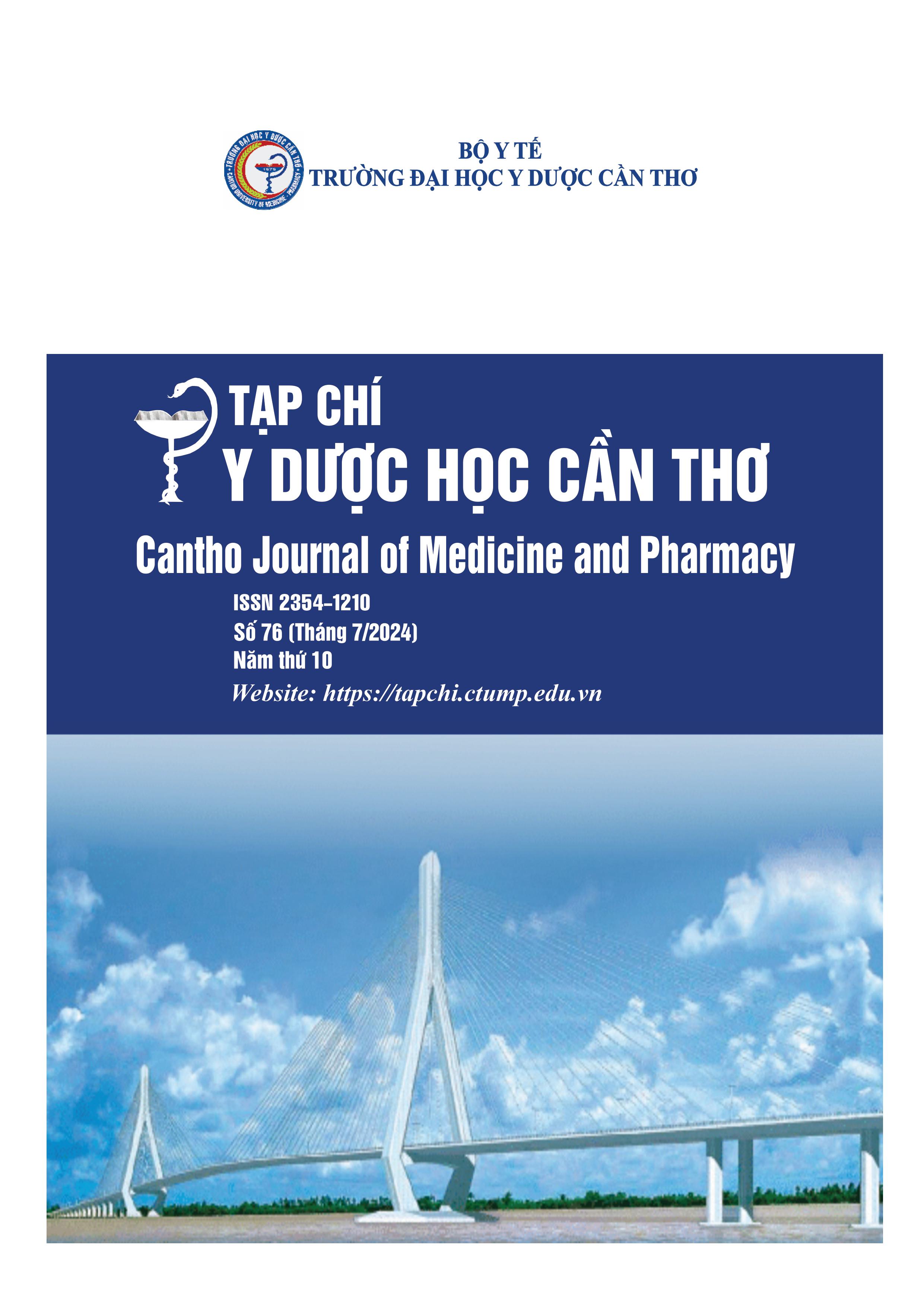RESEARCH THE CHARACTERISTICS AND VALUES OF CHARLSON COMORBIDITY INDEX ON ANTITHROMBOTIC THERAPY BASED ON HAS-BLED SCORE IN OLDER PATIENTS WITH ATRIAL FIBRILLATION AT CAN THO CITY GENERAL HOSPITAL AND CAN THO CENTRAL GENERAL HOSPITAL
Main Article Content
Abstract
Background: Charlson Comorbidity Index is used to be evaluated comorbidity burden in older patients with atrial fibrillation which associates with some factors such as bleeding risk, dosage of acenocoumarol and antiplatelet drug as a combination therapy. Objectives: Study on the characteristics and values of Charlson Comorbidity Index on antithrombotic therapy based on HAS-BLED score in older patients with atrial fibrillation. Materials and methods: A descriptive crosssectional study of 167 older patients with atrial fibrillation at Can Tho City General Hospital and Can Tho Central General Hospital from 2022 to 2024. Results: The most common comorbidity was congrestive heart failure (58.7%). There was a positive correlation between Charlson Comorbidity Index and high bleeding risk (HAS-BLED≥3) with Correlation coefficient (r)=0.35 (p<0.001). The results of a multivariate logistic regression analysis showed that Charlson Comorbidity Index≥2 led to increase about 24 times of antiplatelet prescription (p=0.001) while decreased about 1.5 times of acenocoumarol dose compared to standard dose (p<0.001). Conclusions: Congrestive heart failure was the most common comorbidity in older patients with atrial fibrillation. Charlson Comorbidity Index≥2 predicted increased antiplatelet prescription and high bleeding risk. When Charlson Comorbidity Index≥2, it was necessary to use low acenocoumarol dose compared to standard dose while maintained antiplatelet dose in order to treat multimorbidity.
Article Details
Keywords
atrial fibrillation, Charlson Comorbidity Index, HAS-BLED score, dosage of acenocoumarol
References
2. Proietti, M., Esteve-Pastor, M. A., Rivera-Caravaca, J. M., Roldán, V., Rabadán, I. R., et al. Relationship between multimorbidity and outcomes in atrial fibrillation. Experimental Gerontology. 2021. 153, 111482, https://doi.org/10.1016/j.exger.2021.111482.
3. Trạch, T. T., Hoa, C. N., và Vũ, H. A. Ảnh hưởng của biến thể gen CYP2C9, VKORC1 và yếu tố lâm sàng trên liều acenocoumarol. Đại học Y Dược Thành phố Hồ Chí Minh. 2021. 160.
4. Zhu, Y., You, J., Gu, X. L., Zhu, H., and Liu, J. A retrospective cohort study of pharmacogenetics of warfarin dosing in chinese adults with nonvalvular atrial fibrillation. 2022. https://doi.org/10.21203/rs.3.rs-2146463/v1.
5. Thùy, P. T., Hương, B. T. T. H. và Hương, N. T. Mối liên quan giữa đa hình gen VKORC11639G>A, 1173C>T, CYP2C9*3 và liều thuốc acenocoumarol ở bệnh nhân tim mạch tại bệnh viện Trung Ương Thái Nguyên. Tạp chí Y học Việt Nam. 2021. 500(1), https://doi.org/10.51298/vmj.v500i1.315.
6. Wang, S., Wu, J., Men, C., and Guo, Y. Analysis of the Impact Factors on a Stable Warfarin Dose in Extreme Elderly (Age ≥ 80 Years) Chinese Patients with Non-Valvular Atrial
Fibrillation. World Journal of Cardiovascular Disease. 2020. 10, 329-336, https://doi.org/10.4236/wjcd.2020.105031.
7. Westerman, S., and Wenger, N. Gender Differences in Atrial Fibrillation: A Review of Epidemiology, Management, and Outcome. Current cardiology reviews. 2019. 15(2), 136-144, https://doi.org/10.2174/1573403X15666181205110624.
8. Nicolau, A. M., Corbalan, R., Nicolau, J. C., Ruff, C. T., Zierhut, W., et al. Efficacy and safety of edoxaban compared with warfarin according to the burden of diseases in patients with atrial fibrillation: insights from the ENGAGE AF-TIMI 48 trial. European Heart Heart Journal-
Cardiovascular Pharmacotherapy. 2020. 6(3), 167-175, https://doi.org/10.1093/ehjcvp/pvz061.
9. Jung, M., Yang, P. S., S., Kim, D., Sung, J. H., Jang, E., et al. Multimorbidity in atrial fibrillation for clinical implications using the Charlson Comorbidity Index. International Journal of Cardiology. 2024. 398, 131605, https://doi.org/10.1016/j.ijcard.2023.131605.
10. Gheorghe, G. S., Hodorogea, A. S., Gheorghe, A. C. D., Popa, D. E., Vulpe, S., et al. Decision of anticoagulation in nonvalvular atrial fibrillation in the real world in the non-antivitamin K anticoagulants era. In Healthcare. 2022. 10(7), 1333, https://doi.org/10.3390/healthcare10071333.


